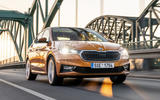What is it?
Skoda may have been handed the mammoth responsibility of developing upcoming small electric cars not only for its own brand but also for Volkswagen (ID 1, ID 2) and Seat (‘Acandra’), but it isn’t neglecting the original crew - very much including the Skoda Fabia.
This is the new and much-changed Fabia, which straight away looks quite a handsome car in light of its lowly and very much unchanged status as the wallet-friendly supermini in the Skoda line-up. It goes on sale in September from around £15,500 (about £19,000 as tested) and will rival the likes of the Peugeot 208, Ford Fiesta, Renault Clio and Toyota Yaris – all of them impressive in their own ways.
While the competition in this class is fierce, the fourth Fabia since the model’s inception in 1999 should be easily the most capable of its lineage yet (spoiler: it is), not least because of the platform it uses. Volkswagen Group’s MQB-A0 chassis also serves the Audi A1 and Volkswagen Polo and Volkswagen T-Cross, and you’d expect it to allow for better road manners than before, aided by improved torsional stiffness in the body, which now uses a much greater proportion of high-grade steel.
The new platform also brings extra interior space. Moving the Fabia on from the veteran PQ35 chassis, which was deployed for the Mk5 Volkswagen Golf, has allowed the wheelbase to grow by 94mm, meaning there’s more leg room in the back of the car. At 380 litres, the new boot is also an exact match in terms of raw capacity for the current Mk8 Volkswagen Golf and beats the Ford Focus – both cars firmly in the class above what is now the Czech brand’s entry-level model, after the Skoda Citigo was retired. The Fabia’s Tardis credentials seem assured.
With the new platform comes a lightly revised engine line-up. It still consists mostly of 1.0-litre three-cylinder petrol units in either MPI (naturally aspirated) or TSI (turbocharged) forms, and these range from a measly 65bhp to a more reassuring 109bhp. In the lower ranks, a five-speed manual gearbox is your only option, but higher outputs bring the choice of having either a six-speed manual or a seven-speed dual-clutch automatic (DSG).
At the top of the range sits a solitary 1.5-litre four-cylinder TSI unit with 148bhp, and paired with the DSG ’box only. We’ve tried this particular engine before in other VW Group wares and we like its blend of potency, smoothness and economy. However, Skoda suspects most buyers will opt for one of the triples, which along with both gearbox options are built by Skoda in the Czech Republic. Given the Fabia is also put together in one of Skoda’s Czech plants, it means that despite the VW Group umbrella that sits over the brand, the car is built very much ‘in-house’ by automotive standards.
Note finally that diesel, which Skoda championed with the original Fabia vRS, is nowhere to be seen, and won’t make an appearance on the upcoming Fabia Estate, either. Neither will any mild hybrids, for that matter – they’d push up the price too much.

































Join the debate
Add your comment
The decision to market the larger engine (TSI 150 PS) with a dual-clutch gearbox baffles me!
I drive An IBIZA with that engine but mated a 6-speed manual gearbox (my choice) and quite frankly, it is a match made in heaven!
Pootle along in 5th or 6th at virtually tick-over revs and then drop into 3rd for a blast past some traffic or just for fun before slotting straight back into 6th: there is ample torque to do that!
The car is fun, it is a bit of a Q-car and its economy is remarkable: 5.8 L/100km is the norm! That is just over 48 mpg for a sub-8s 0-100km/h.
There must be a good explanation: anyone out there?
Why would people particularly be bothered about the smaller foorprint of this Fabia compared to say a Focus?
I'd be much more concerned about its external dimensions.